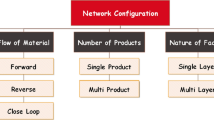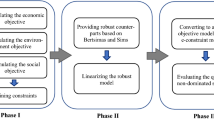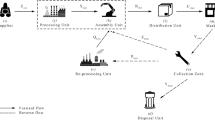Abstract
Analyzing current trends in supply chain management, lead to find unavoidable steps toward closing the loop of supply chain. In order to expect best performance of Closed-Loop Supply Chain (CLSC) network, an integrated approach in considering design and planning decision levels is necessary. Further, real markets usually contain uncertain parameters such as demands and prices of products. Therefore, the next important step is considering uncertain parameters.
In order to cope with designing and planning a closed-loop supply chain, this paper proposes a multi-period, multi-product closed-loop supply chain network with stochastic demand and price in a Mixed Integer Linear Programming (MILP) structure. A multi criteria scenario based solution approach is then developed to find optimal solution through some logical scenarios and three comparing criteria. Mean, Standard Deviation (SD), and Coefficient of Variation (CV), which are the mentioned criteria for finding the optimal solution. Sensitivity analyses are also undertaken to validate efficiency of the solution approach. The computational study reveals the acceptability of proposed solution approach for the stochastic model. Finally, a real case study in an Indian manufacturer is evaluated to ensure applicability of the model and the solution methodology.






Similar content being viewed by others
References
Chopra, S., & Meindl, P. (2007). Supply chain management: strategy, planning and operation. Upper Saddle River: Pearson/Prentice Hall.
Amin, S. H., & Zhang, G. (2012). An integrated model for closed-loop supply chain configuration and supplier selection: multi-objective approach. Expert Systems with Applications, 39(8), 6782–6791.
Amin, S. H., & Zhang, G. (2013). A three-stage model for closed-loop supply chain configuration under uncertainty. International Journal of Production Research, 51(5), 1405–1425.
Chouinard, M., D’Amours, S., & Aït-Kadi, D. (2008). A stochastic programming approach for designing supply loops. International Journal of Production Economics, 113(2), 657–677.
Dembo, R. S. (1991). Scenario optimization. Annals of Operations Research, 30(1), 63–80.
El-Sayed, M., Afia, N., & El-Kharbotly, A. (2010). A stochastic model for forward-reverse logistics network design under risk. Computers & Industrial Engineering, 58(3), 423–431.
Faccio, M., Persona, A., Sgarbossa, F., & Zanin, G. (2011). Multi-stage supply network design in case of reverse flows: a closed-loop approach. International Journal of Operational Research, 12(2), 157–191.
Francas, D., & Minner, S. (2009). Manufacturing network configuration in supply chains with product recovery. Omega, 37(4), 757–769.
Guide, V. D. R., & Van Wassenhove, L. N. (2009). OR forum—the evolution of closed-loop supply chain research. Operations Research, 57(1), 10–18.
Kaut, M., & Wallace, S. W. (2007). Evaluation of scenario-generation methods for stochastic programming. Pacific Journal of Optimization, 3(2), 257–271.
Krarup, J., & Pruzan, P. M. (1983). The simple plant location problem: survey and synthesis. European Journal of Operational Research, 12(1), 36–81.
Lamming, R., & Hampson, J. (1996). The environment as a supply chain management issue. British Journal of Management, 7(s1), S45–S62.
Listeş, O. (2007). A generic stochastic model for supply-and-return network design. Computers & Operations Research, 34(2), 417–442.
Ogryczak, W. (2000). Multiple criteria linear programming model for portfolio selection. Annals of Operations Research, 97(1–4), 143–162.
Özceylan, E., & Paksoy, T. (2013). Fuzzy multi objective linear programming approach for optimizing a closed-loop supply chain network. International Journal of Production Research, 51(8), 2443–2461.
Özkır, V., & Başlıgil, H. (2013). Multi-objective optimization of closed-loop supply chains in uncertain environment. Journal of Cleaner Production, 41, 114–125.
Pishvaee, M. S., & Torabi, S. A. (2010). A possibilistic programming approach for closed-loop supply chain network design under uncertainty. Fuzzy Sets and Systems, 161(20), 2668–2683.
Pishvaee, M. S., Rabbani, M., & Torabi, S. A. (2011). A robust optimization approach to closed-loop supply chain network design under uncertainty. Applied Mathematical Modelling, 35(2), 637–649.
Pokharel, S., & Mutha, A. (2009). Perspectives in reverse logistics: a review. Resources, Conservation and Recycling, 53(4), 175–182.
Ramezani, M., Bashiri, M., & Tavakkoli-Moghaddam, R. (2013). A new multi-objective stochastic model for a forward/reverse logistic network design with responsiveness and quality level. Applied Mathematical Modelling, 37(1–2), 328–344.
Sasikumar, P., & Kannan, G. (2009). Issues in reverse supply chain, part III: classification and simple analysis. International Journal of Sustainable Engineering, 2(1), 2–27.
Schrijver, A. (2003). Combinatorial optimization: polyhedra and efficiency. Berlin: Springer.
Soleimani, H., Seyyed-Esfahani, M., & Shirazi, M. A. (2013). Designing and planning a multi-echelon multi-period multi-product closed-loop supply chain utilizing genetic algorithm. The International Journal of Advanced Manufacturing Technology. doi:10.1007/s00170-013-4953-6.
Subramoniam, R., Huisingh, D., & Chinnam, R. B. (2009). Remanufacturing for the automotive aftermarket-strategic factors: literature review and future research needs. Journal of Cleaner Production, 17(13), 1163–1174.
Tonanont, A., Yimsiri, S., Jitpitaklert, W., & Rogers, K. J. (2008). Performance evaluation in reverse logistics with data envelopment analysis. In Proceedings of the 2008 industrial engineering research conference (pp. 764–769).
Zhou, G., & Min, H. (2011). Designing a closed-loop supply chain with stochastic product returns: a genetic algorithm approach. International Journal of Information Systems for Logistics and Management, 9(4), 397–418.
Zhu, X., & Xiuquan, X. U. (2013). An integrated optimization model of a closed-loop supply chain under uncertainty. In LISS 2012 (pp. 1389–1395). Berlin: Springer.
Author information
Authors and Affiliations
Corresponding author
Rights and permissions
About this article
Cite this article
Soleimani, H., Seyyed-Esfahani, M. & Shirazi, M.A. A new multi-criteria scenario-based solution approach for stochastic forward/reverse supply chain network design. Ann Oper Res 242, 399–421 (2016). https://doi.org/10.1007/s10479-013-1435-z
Published:
Issue Date:
DOI: https://doi.org/10.1007/s10479-013-1435-z




